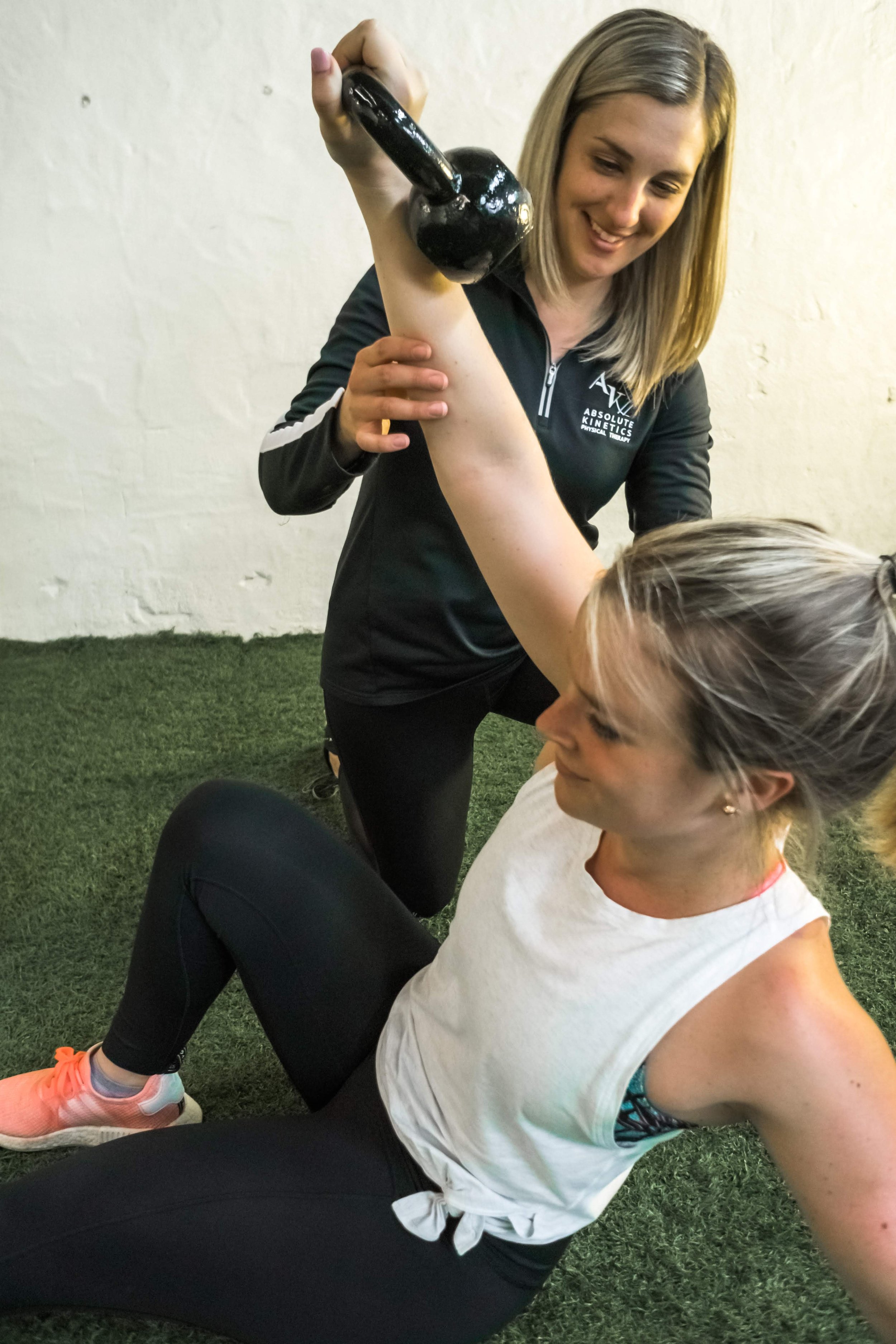Absolute Kinetics Physical Therapy Blog
How Does Physical Therapy Help with Pelvic Pain?
Pelvic Pain is often described as a discomfort or painful/abnormal sensation anywhere around the pelvis, including but not limited to the abdomen, pelvis, and perineum. This covers a vast amount of different diagnoses, but there is one thing the majority of them have in common; pelvic health physical therapy can drastically help improve symptoms and quality of life.
Do You Take My Insurance?
Absolute Kinetics has chosen a cash-based model for our practice. We feel this model is the most efficient and effective way to provide physical therapy services. Here are a few benefits of the cash-based model.
What Type of Exercise Should I Do If I Am Hypermobile?
We see a lot of patients in our clinic who have some level of hypermobility, and most of them don't feel clear about what they should and should not be doing in the gym. If you have read any of our blog posts in the past, I am sure you know the first thing I am going to say: it depends.
“But I Only Pee When I Jump…”
This is one of the most common things I hear. Imagine you come in for a physical therapy appointment with a primary complaint of hip or low back pain. As a pelvic health PT, I ask you a lot of questions you probably aren’t used to but that are related to how the pelvic floor muscles are functioning (how many times do you pee in a day? Is your urine stream straight or does it veer to the side? What does your poop look like? Do you have pain with sex? Are you able to orgasm?). You say that you don’t really have urinary leakage, but whenever you do jumping jacks or double unders, you do pee a tiny bit. That’s normal, right? Nope!
What is Pelvic Organ Prolapse?
Pelvic Organ Prolapse (POP) occurs when there is weakness in the supportive ligaments/muscles, perineum, or the vaginal/rectal wall itself. This weakness can cause either the uterus, bladder, rectum, or small intestine to push into the vaginal wall, often causing symptoms.
The Top 5 Myths About Diastasis Recti
Diastasis Recti Abdominis (DRA) is often described as the separation of the rectus abdominis muscles and is too often associated with fear and anxiety. At Absolute Kinetics, words and education matter to us in our goal to empower you, so we want to set the record straight by debunking some common myths.
The Immune System - Guest Blog Post by Evie Takacs, MS of Holistically Restored Health Coaching
When we think of the human body in today’s modern culture, we often think of ways to stop it from doing something. We take pain medication for any ailment and will often suppress symptoms to simply get rid of them. But what if we stopped looking at symptoms as problems and started treating them as communication from our body? How well are we listening to what our body is telling us?
What is Shoulder Impingement?
Shoulder pain is a common occurrence and can have a large impact on daily activities. The shoulder is one of the most complex joints in the body, consisting of the scapula (shoulder blade), glenohumeral joint, and clavicle (collar bone). One of the most common shoulder diagnoses we see is shoulder impingement. Shoulder impingement is the pinching of a tendon, most commonly the supraspinatus tendon and sometimes the infraspinatus tendon, due to faulty mechanics of the shoulder. Shoulder impingement can occur due to repetitive motions, muscular imbalances and prolonged poor posture, and/or injury to the shoulder joint that creates inflammation. Some individuals are at a higher risk of developing shoulder impingement due to the shape of the end of their clavicle or if they have bursitis (inflammation of the bursa that sits under the end of the clavicle). Impingement symptoms commonly occur with reaching overhead, reaching behind your back, or throwing, and pain can occur in the top (superior) or back (posterior) of the shoulder.
How Sore Should I Be After a Work Out?
We've heard from many patients who judge the effectiveness of a work out by how sore they are the next day. "No pain, no gain", right? But is that really a sign of a good training (or rehab) program Short answer: absolutely not.
Should I Get a Standing Desk?
We have recently been talking to many of our patients about their home office set up. Working from home can be challenging for many reasons, one of them being the ergonomic set up of your home office. This also brings up a common question that we get from those who work from home and/or in an office doing a job that primarily requires being on the computer: should I get a standing desk?
Tips to Safely Return to the Gym After a Long Break
As the world starts to reopen, many people are excited to get back in the gym. Whether you've been working out at home, running outside, or have taken this time to take a break from working out all together, there are a few things to keep in mind before you head back to the gym.
Tips for Shoveling Snow Without Back Pain
As we have mentioned in previous blog posts, low back pain is a common diagnosis among Americans and one of the most common things we treat at Absolute Kinetics Physical Therapy. In Ohio, there are 2 times of the year when we see an even larger number of patients with low back pain: the first nice weekend in May when patients dedicate an entire Saturday to yard work, and the first big snowfall of the year. With the first snow coming early to Cincinnati this year, we want to share a few tips for preventing injury to your low back while shoveling snow.
What Can I Do About Pain in the Front of my Knee?
Have you experienced pain in the front of your knee with walking, running, squatting, going up and down stairs, or other activities? Pain in the front (anterior) knee is often diagnosed as Patellofemoral Pain Syndrome. Patellofemoral pain (PFP) can occur across the life span, from young children to older adults, however it is found to be most common between 12 and 19 years of age and 50 - 59 years of age. There are varying reports of prevalence, but idiopathic (no known cause) PFP is most commonly noted as having a prevalence of about 25% of the population. This pain is typically described as a nagging ache or a sharp twinge.
Does Sleep Affect My Pain?
When you ask most people how much sleep they should be getting each night, they will typically tell you 7-8 hours. When you ask them how much they actually get, it is usually quite a bit less than this. In a world where we are constantly on the go, "grinding" as business professionals or small business owners, while taking care of our homes and families, it is difficult to find enough hours in the day to accomplish all of the tasks on our to do list. The first place many people steal time from is the hours they should be spending sleeping.
Does Posture Really Matter?
No matter where you are searching on the internet for information, you can find conflicting information on just about anything. Recently my husband and I have found ourselves doing a lot of “internet research” on different baby products as we are preparing for our son to arrive in November. The only thing we’ve really learned is that we should have no idea what to expect until he is actually here and we try things out! Every mom and dad have different opinions on the best products, the best way to make adjustments to a new baby in your life, sleep training, etc.
Why is Foot Strength Important?
The foot is our connection to the ground when we are standing, and the first thing to touch the ground when we are walking or running. It is the first joint to accept impact during these activities. Many people only consider strengthening or working on mobility of their feet if they are experiencing pain in their foot, however, weakness and stiffness in the feet can lead to problems in other joints as well. Many individuals that present with knee pain, hip pain, or lower back pain also have weakness in their feet that cause dysfunctional walking patterns or increased stress on their joints when standing, walking, negotiating stairs, and participating in other exercises and activities.
How Much Activity Should I be Doing to Stay Healthy?
As Physical Therapists, we often focus our treatment sessions and education on how to address or manage pain, how to prevent or mitigate injury, and how to rehab after an injury or surgery. However, part of our role is also to educate the public on how movement and exercise can affect their health long term not only when it comes to preventing pain and injury to the musculoskeletal system, but keeping all systems healthy and preventing disease.
How Do I Train the Systems Involved in Balance?
Last weeks post talked about the 3 main systems involved in balance - somatosensory, visual, and vestibular. These systems are not only important in keeping us upright and balanced, but also play a large role in any dynamic activities (running, walking, weight lifting, playing sports, etc) that we participate in. In order to maximize our training, we need to make sure we are training ALL of these systems, not just working specifically on our sport or strengthening our musculoskeletal system.
What is the role of balance in rehab and training?
When most people think of "balance" or going to physical therapy to address balance, the image that pops into their mind is their elderly parent or grandparent walking with a cane or walker, with a gait belt around their waist and a PT holding on "just in case". Although balance training is absolutely crucial for safety and independence in older individuals, balance training is also equally beneficial for athletes and active individuals of all ages.
What can I do about bunions?
As we post more information and exercises for the feet, we are commonly asked about bunions. Those who have bunions are very familiar with what they are. For those who do not have bunions, a bunion is a bony formation on the medial side at the base of the big toe (the metatarsophalangeal joint, or MTP). This bump is caused due to the big toe being pushed in toward the other toes, sometimes so far that it actually will sit on top of the next toe in. Some individuals also form a Tailor’s bunion, which is along the lateral side of the little toe. For this discussion, we are going to focus on bunions at the first MTP joint.




















